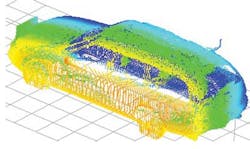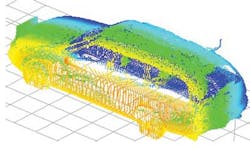VISION-GUIDED ROBOTICS: 3-D vision optimizes robotic car parking
The shortage of parking spaces in many European cities is a problem for many motorists. But even when level parking garages are available, the space in them is never used optimally; much of it is dedicated to interior ramps and pedestrian walkways.
To solve this problem, serva transport systems (http://serva-ts.com) and in-situ Vision & Sensor Systems have developed a fully automated car parking system that makes use of more of the space in a parking garage by first identifying a vehicle and then transporting it to an empty parking slot using a self-guided robot trolley.
A driver is guided to position their vehicle at a specific location in a bay within the garage by following instructions on a large display in front of the vehicle. After the driver has exited the vehicle, a 5-Mpixel camera with GigE interface from Basler placed directly in front of it captures an image of the license plate number, which is identified by PC-based optical character recognition (OCR) software from Neural Labs (www.neurallabs.net). The driver then manually verifies that the system has correctly identified this plate number at a computer-based display station located near the vehicle.
In addition to recognizing the license plate of the car, the system is used to generate a 3-D model of each vehicle. To do so, the system employs four infrared (IR) 3-D cameras with built-in structured-light scanners that are mounted on poles surrounding the car. By scanning across the car, each camera captures a 3-D image of the vehicle from four different perspectives.
The four 3-D images are then transferred to the PC over Ethernet where the point cloud information obtained is combined into one 3-D image of the vehicle. The PC-based software developed by in-situ then extracts features within the point cloud to determine the shape of the vehicle's wheels.
By calculating the shape of the individual wheels, the system determines the wheel diameters and positions, the specific angle at which the vehicle is sitting within the bay, and whether any objects are surrounding the car that might impede the robot trolley.
Once the position and orientation of the car have been determined to an accuracy of 1 cm and the system has verified that no objects are in the path of the trolley, the data are sent wirelessly to the trolley. This trolley locates the vehicle, grabs it at the wheels, lifts it approximately 5 in., and transports it to an empty slot within the parking garage.
Four additional 5-Mpixel cameras from Basler, mounted on the same poles as the 3-D cameras, are used to capture an image of the entire vehicle. This enables the owners of the parking facility to store a permanent visual record of the state of the exterior of the vehicle prior to parking.
Upon returning to the bay to recover their vehicle, the driver is instructed to enter the license plate identifier at the computer-based display station, after which the robot retrieves the vehicle from the garage.
According to Prof. Dr. Hartmut Ernst, managing director of in-situ, two vision-based systems are currently deployed at a parking garage in the Dusseldorf region of Germany.

